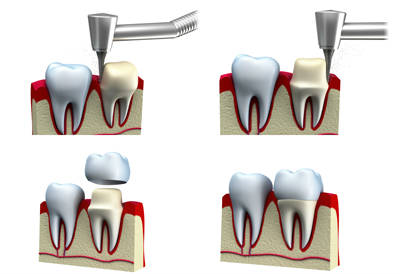A dental crown is a tooth shaped “cap” that fits snuggly over a tooth, completely covering it. Usually a crown is required to restore the size, shape, strength, or appearance of a tooth. We can fix teeth with dental crowns by encasing the visible portion of the tooth that lies above the gum line.
Your doctor for dental crowns may recommend this procedure in the following situations:
- If you have a weak tooth, such as from decay, you may need a crown to prevent the tooth from breaking or to hold together parts of a cracked tooth.
- If you have a tooth that is already broken or that has been severely worn down, you may need a crown.
- Crowns can also be used to cover and support a tooth with a large filling when there is not much tooth structure left.
- Crowns can be used to hold a dental bridge in place.
- Crowns can be placed over misshapen or discolored teeth.
- If you have had a dental implant placed, an implant crown will be used to restore the original function of the lost tooth.
- You may need a crown to cover a tooth that has had a root canal.

The Procedure
Preparing a tooth for a crown usually takes two office visits, but may occasionally involve a third visit. The first visit to fix teeth with dental crowns will be to prepare the tooth. During this first appointment, your doctor for dental crowns will take x-rays to ensure that the root of the tooth and surrounding bone are healthy enough to support a dental crown. If the tooth has significant decay that has gone into the nerve, then a root canal may be required before a crown can be placed. It is a very common practice to fix teeth with dental crowns.
Before the procedure begins, the doctor will numb your tooth and surrounding gum tissue. The tooth receiving the crown will be prepared along the chewing surface and sides to make room for the crown material. After the tooth has been reshaped, your doctor for dental crowns will take an impression of the tooth if the gum tissues are healthy enough at this time. This impression will be used to create your unique crown. Manufacturing of the crown occurs in a dental lab and usually takes two to three weeks. A temporary crown will be fabricated for you to wear until your permanent crown is available for cementation.
During your second visit, we will check the health of your tissue. Healthy gums ensure the most effective cementation of the crown. If not done so at your first visit, an impression will be taken for the fabrication of the permanent crown.
At your last visit, the crown will be tried in and cemented in place. Your bite will be checked to ensure proper function and comfort, and adjustments will be made if necessary.